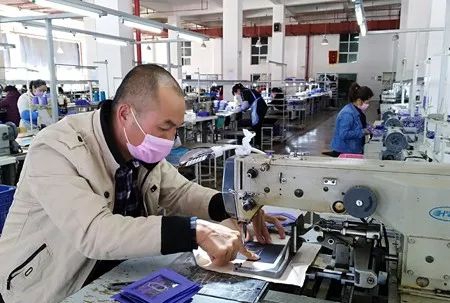Since returning to work and production on February 10th, our factory has achieved a good start in the first month of its return to work by focusing on epidemic prevention and control and production development, with a steady stream of customer orders.
Into the production workshop, the scene can be seen a busy scene, mechanical rumbling, hundreds of workers are nervous orderly work.

Since February 10, we began to resume work. The current workers are more than 300 people, are mainly local, less than half of the staff in previous years. Before starting work, all areas in the factory were disinfected and workers took their temperature twice a day on the job, putting employee safety first. The production of materials is basically the Spring Festival forward. The current day can produce 60,000 bags.
Now the factory is normal, the company has more than 300 people back to work. On the premise of the start of work, our factory has made epidemic prevention measures, every morning to work for temperature detection, each person issued a mask, the afternoon and temperature detection. It is understood that as one of the earlier enterprises, we focused on the early planning and preparation of the resumption of work and production, paid close attention to the implementation of the prevention and control mechanism, staff investigation, prevention and control materials, internal management and other aspects, and made every effort to promote the resumption of work and production.

Coronavirus (COVID-19) Prevention: 10 Tips and Strategies
1. Wash your hands frequently and carefully
Use warm water and soap and rub your hands for at least 20 seconds. Work the lather to your wrists, between your fingers, and under your fingernails. You can also use an antibacterial and antiviral soap.
Use hand sanitizer when you cannot wash your hands properly. Rewash your hands several times a day, especially after touching anything, including your phone or laptop.
2. Avoid touching your face
SARS-CoV-2 can live on some surfaces for up to 72 hours. You can get the virus on your hands if you touch a surface like:
● gas pump handle
● your cell phone
● a doorknob
Avoid touching any part of your face or head, including your mouth, nose, and eyes. Also avoid biting your fingernails. This can give SARS-CoV-2 a chance to go from your hands into your body.
3. Stop shaking hands and hugging people — for now
Similarly, avoid touching other people. Skin-to-skin contact can transmit SARS-CoV-2 from one person to another.
4. Cover your mouth and nose when you cough and sneeze
SARS-CoV-2 is found in high amounts in the nose and mouth. This means it can be carried by air droplets to other people when you cough, sneeze, or talk. It can also land on hard surfaces and stay there for up to 3 days.
Use a tissue or sneeze into your elbow to keep your hands as clean as possible. Wash your hands carefully after you sneeze or cough, regardless.
5. Clean and disinfect surfaces
Use alcohol-based disinfectants to clean hard surfaces in your home like:
countertops
door handles
furniture
toys
Also, clean your phone, laptop, and anything else you use regularly several times a day.
Disinfect areas after you bring groceries or packages into your home.
Use white vinegar or hydrogen peroxide solutions for general cleaning in between disinfecting surfaces.
6. Take physical (social) distancing seriously
If you’re carrying the SARS-CoV-2 virus, it’ll be found in high amounts in your spit (sputum). This can happen even if you don’t have symptoms.
Physical (social) distancing, also means staying home and working remotely when possible.
If you must go out for necessities, keep a distance of 6 feet (2 m) from other people. You can transmit the virus by speaking to someone in close contact to you.
7. Do not gather in groups
Being in a group or gathering makes it more likely that you’ll be in close contact with someone.
This includes avoiding all religious places of worship, as you may have to sit or stand too close to another congr
8. Avoid eating or drinking in public places
Now is not the time to go out to eat. This means avoiding restaurants, coffee shops, bars, and other eateries.
The virus can be transmitted through food, utensils, dishes, and cups. It may also be temporarily airborne from other people in the venue.
You can still get delivery or takeaway food. Choose foods that are thoroughly cooked and can be reheated.
High heat (at least 132°F/56°C, according to one recent, not-yet-peer-reviewed lab study) helps to kill coronaviruses.
This means it may be best to avoid cold foods from restaurants and all food from buffets and open salad bars.
9. Wash fresh groceries
Wash all produce under running water before eating or preparing.
The CDCTrusted Source and the FDATrusted Source do not recommend using soap, detergent, or commercial produce wash on things like fruits and vegetables. Be sure to wash hands before and after handling these items.
10. Wear a mask
The Centers for Disease Control and Prevention (CDC) recommends Trusted Source that almost everyone wears a cloth face mask in public settings where physical distancing may be difficult, such as grocery stores.
When used correctly, these masks can help prevent people who are asymptomatic or undiagnosed from transmitting SARS-CoV-2 when they breathe, talk, sneeze, or cough. This, in turn, slows the transmission of the virus.
Post time: Jan-14-2021
